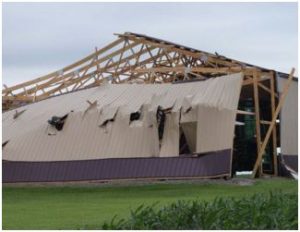All too often we read, hear or see news of tragic events in our world – earthquakes, hurricanes, tornadoes….not to underscore the loss of human life, but property damages are huge – homes, barns, businesses are damaged or destroyed.
After the dust settles (or the waters recede), the first thoughts are how to “get back on one’s feet”. This usually brings about thoughts of how to repair damaged structures. Building repair can be a tricky undertaking. Truthfully, unless damages are minor, it can often be less expensive to knock the building to the ground and rebuild. Initial inspection of damaged buildings does not usually disclose the full extent of needed repairs. Even when repairs are completed, undamaged portions of buildings are often times left as not being compliant to current building codes.
The essential keys to recovery from a catastrophic loss are time and budget.
Time – there is no permanent structure which can be erected in as short a time period as a pole building. From concept to delivery onsite is often a matter of weeks, not months. When I was a building contractor, I had a four man crew who could leave the office Monday morning and return at noon on Friday with the final check from putting up a 7200 square foot building with 16 foot tall walls. It was not uncommon for experienced three person crews to construct two 1000 to 1500 square foot buildings in the same week. Pole buildings are so easy to build, the average “weekend warrior” who can and will read instructions can build a fairly good sized building in a few weekends.
Budget – even an all steel building cannot compete with the cost effectiveness of a pole building. During World War II, the U.S. government imposed a $1,500 limitation on the amount which could spend on constructing new barns. The pole-barn building method, which eliminated up to two-thirds of the lumber needed by other systems, made the government’s guidelines attainable. Unlike stick frame construction, every piece in a pole building has a direct structural function. Redundant and unnecessary members are eliminated (often still used on stick framed buildings).
Besides the efficiency of the pole building framework, footing and foundation costs are significantly reduced. Pole buildings eliminate the need for continuous footings and foundation walls. This results in savings in equipment for excavation, lumber for forms, significant amounts of concrete as well as manpower.
When life has been turned upside down by disaster, the building to turn to is a pole building. By the time the wreckage is cleared, your new building has been delivered. Before your neighbors have even given thought to their solution, you and your loved ones are once again safe and protected from the elements.






